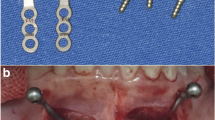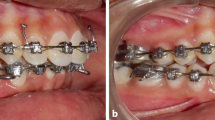Abstract
Objective
Aim of this retrospective study was to compare soft tissue effects of Class II treatments with the forsus fatigue resistant device (FRD), the pendulum appliance, and the extraction of two maxillary premolars, all of which were combined with pre-adjusted fixed appliances.
Patients and methods
The sample of 54 patients with Class II malocclusions was divided in three groups: group I patients (mean age = 15.91 years) were treated with the FRD concurrently used with fixed appliances; group II patients (mean age = 16.08 years) were treated with the pendulum appliance combined with a Nance and headgear followed by fixed appliances; and group III patients (mean age = 19.04 years) were treated with the extraction of two maxillary premolars with miniscrew anchorage. Soft tissue and dentoskeletal parameters were measured on pretreatment (T1) and posttreatment (T2) lateral cephalograms. The changes from T1 to T2 were compared between the groups using Kruskal–Wallis test, and treatment differences were evaluated with the Wilcoxon test at p < 0.05.
Result
Soft tissue measurement changes related to the upper and lower lips were significantly greater in group II than in group III (p < 0.05). Upper incisor measurement changes were significantly different between groups II and III. Lower incisor measurement changes were significantly different between groups I and III and groups II and III (p < 0.05).
Conclusions
Pendulum and extraction treatment groups showed significant differences in relation with the upper and lower lip positional changes, which were significantly greater in the pendulum group. Treatment time with the extraction treatment was statistically shorter than with the nonextraction protocols.
Zusammenfassung
Zielsetzung
In dieser retrospektiven Untersuchung sollte verglichen werden, welche Weichgewebeauswirkungen bei drei verschiedenen Klasse-II-Behandlungen entstehen: mittels einer gegen Ermüdung beständig(er)en Forsus-Apparatur (Forsus Fatigue Resistant Device, FRD), einer Pendulum-Apparatur bzw. der Extraktion zweier Prämolaren im Oberkiefer. Jede Behandlungsvariante war kombiniert mit vorher individuell angepassten festsitzenden kieferorthopädischen Apparaturen.
Patienten und Methoden
Insgesamt 54 Patienten mit Klasse-II-Malokklusion wurden in 3 Gruppen aufgeteilt: Patienten der Gruppe I (Altersdurchschnitt 15,91 Jahre) wurden gleichzeitig mit der FRD und festsitzenden Apparaturen behandelt, Patienten der Gruppe II (16,08) mit der Pendulum-Apparatur in Kombination mit einer Nance-Apparatur sowie einem Headgear, und Patienten der Gruppe III (19,04) mit Prämolarenextraktion und Minischrauben-Verankerung. Auf Fernseitenaufnahmen wurden Weichgewebe- und dentoskelettale Parameter vor (T1) und nach (T2) der Behandlung vermessen. Veränderungen zwischen T1 und T2 wurden zwischen den beiden Gruppen mit dem Kruskal–Wallis-Test verglichen, behandlungsbedingte Unterschiede wurden mit dem Wilcoxon-Test evaluiert (p < 0,05).
Ergebnisse
Die Weichgewebeveränderungen in Bezug auf Ober- und Unterlippe waren in der Gruppe II statistisch signifikant stärker ausgeprägt als in Gruppe III (p < 0,05). Die Veränderungen im Bereich der oberen Inzisiven waren in beiden o.a. Gruppen signifikant unterschiedlich. Die Messungen im Bereich der unteren Inzisiven unterschieden sich signifikant sowohl zwischen den Gruppen I und III als auch zwischen den Gruppen II und III (p < 0,05).
Schlussfolgerung
In der Pendulum- und in der Extraktionsgruppe zeigten sich signifikante Unterschiede hinsichtlich der Positionsveränderungen von Ober- und Unterlippe. Diese waren in der Pendulumgruppe deutlich stärker ausgeprägt als in der Extraktionsgruppe. Die Behandlungszeit war bei der Extraktionstherapie signifikant kürzer als bei den Non-Extraktionsbehandlungen.




Similar content being viewed by others
References
Angelieri F, Almeida RR, Almeida MR, Fuziy A (2006) Dentoalveolar and skeletal changes associated with the pendulum appliance followed by fixed orthodontic treatment. Am J Orthod Dentofacial Orthop 129:520–527
Baccetti T, Franchi L, Stahl F (2009) Comparison of 2 comprehensive Class II treatment protocols including the bonded Herbst and headgear appliances: a double-blind study of consecutively treated patients at puberty. Am J Orthod Dentofacial Orthop 135:698 e691–10; discussion 698–699
Basciftci FA, Usumez S (2003) Effects of extraction and nonextraction treatment on class I and class II subjects. Angle Orthod 73:36–42
Bock N, Pancherz H (2006) Herbst treatment of Class II division 1 malocclusions in retrognathic and prognathic facial types. Angle Orthod 76:930–941
Bock NC, Santo C, Pancherz H (2009) Facial profile and lip position changes in adult Class II, Division 2 subjects treated with the Herbst-Multibracket appliance. A radiographic cephalometric pilot study. J Orofac Orthop 70:51–62
Booij JW, Goeke J, Bronkhorst EM, Katsaros C, Ruf S (2013) Class II treatment by extraction of maxillary first molars or Herbst appliance: dentoskeletal and soft tissue effects in comparison. J Orofac Orthop 74:52–63
Burkhardt DR, McNamara JA Jr, Baccetti T (2003) Maxillary molar distalization or mandibular enhancement: a cephalometric comparison of comprehensive orthodontic treatment including the pendulum and the Herbst appliances. Am J Orthod Dentofacial Orthop 123:108–116
Bussick TJ, McNamara JA Jr (2000) Dentoalveolar and skeletal changes associated with the pendulum appliance. Am J Orthod Dentofacial Orthop 117:333–343
Cacciatore G, Alvetro L, Defraia E, Ghislanzoni LT, Franchi L (2014) Active-treatment effects of the Forsus fatigue resistant device during comprehensive Class II correction in growing patients. Korean J Orthod 44:136–142
Cacciatore G, Ghislanzoni LT, Alvetro L, Giuntini V, Franchi L (2014) Treatment and posttreatment effects induced by the Forsus appliance: a controlled clinical study. Angle Orthod 84:1010–1017
Caprioglio A, Cafagna A, Fontana M, Cozzani M (2015) Comparative evaluation of molar distalization therapy using pendulum and distal screw appliances. Korean J Orthod 45:171–179
Chiu PP, McNamara JA Jr, Franchi L (2005) A comparison of two intraoral molar distalization appliances: distal jet versus pendulum. Am J Orthod Dentofacial Orthop 128:353–365
Coben SE (1971) The biology of Class II treatment. Am J Orthod 59:470–487
de Almeida-Pedrin RR, Henriques JF, de Almeida RR, de Almeida MR, McNamara JA Jr (2009) Effects of the pendulum appliance, cervical headgear, and 2 premolar extractions followed by fixed appliances in patients with Class II malocclusion. Am J Orthod Dentofacial Orthop 136:833–842
Flores-Mir C, Major MP, Major PW (2006) Soft tissue changes with fixed functional appliances in Class II division 1. Angle Orthod 76:712–720
Franchi L, Alvetro L, Giuntini V, Masucci C, Defraia E, Baccetti T (2011) Effectiveness of comprehensive fixed appliance treatment used with the Forsus Fatigue Resistant Device in Class II patients. Angle Orthod 81:678–683
Franchi L, Baccetti T, McNamara JA Jr (2000) Mandibular growth as related to cervical vertebral maturation and body height. Am J Orthod Dentofacial Orthop 118:335–340
Gao W, Li X, Bai Y (2014) An assessment of late fixed functional treatment and the stability of Forsus appliance effects. Aust Orthod J 30:2–10
Ghosh J, Nanda RS (1996) Evaluation of an intraoral maxillary molar distalization technique. Am J Orthod Dentofacial Orthop 110:639–646
Gong Y, Li PL, Wang HH, Yu Q, Wei B, Shen G (2015) Soft tissue linear evaluation of fixed Twin-block appliance treatment and tooth extraction in skeletal Class II malocclusion. Shanghai Kou Qiang Yi Xue 24:232–235
Hilgers JJ (1992) The pendulum appliance for Class II non-compliance therapy. J Clin Orthod 26:706–714
Illing HM, Morris DO, Lee RT (1998) A prospective evaluation of Bass, Bionator and Twin Block appliances. Part I-The hard tissues. Eur J Orthod 20:501–516
Janson G, Fuziy A, de Freitas MR, Castanha Henriques JF, de Almeida RR (2007) Soft-tissue treatment changes in Class II Division 1 malocclusion with and without extraction of maxillary premolars. Am J Orthod Dentofacial Orthop 132(729):e721–e728
Karacay S, Akin E, Olmez H, Gurton AU, Sagdic D (2006) Forsus Nitinol Flat Spring and Jasper Jumper corrections of Class II division 1 malocclusions. Angle Orthod 76:666–672
Kinzinger G, Frye L, Diedrich P (2009) Class II treatment in adults: comparing camouflage orthodontics, dentofacial orthopedics and orthognathic surgery—a cephalometric study to evaluate various therapeutic effects. J Orofac Orthop 70:63–91
Kuroda S, Sugawara Y, Yamashita K, Mano T, Takano-Yamamoto T (2005) Skeletal Class III oligodontia patient treated with titanium screw anchorage and orthognathic surgery. Am J Orthod Dentofacial Orthop 127:730–738
McNamara JA Jr (1981) Components of class II malocclusion in children 8–10 years of age. Angle Orthod 51:177–202
Shell TL, Woods MG (2003) Perception of facial esthetics: a comparison of similar class II cases treated with attempted growth modification or later orthognathic surgery. Angle Orthod 73:365–373
Sloss EA, Southard KA, Qian F et al (2008) Comparison of soft-tissue profiles after treatment with headgear or Herbst appliance. Am J Orthod Dentofacial Orthop 133:509–514
Stephens CK, Boley JC, Behrents RG, Alexander RG, Buschang PH (2005) Long-term profile changes in extraction and nonextraction patients. Am J Orthod Dentofac. Orthop 128:450–457
Tadic N, Woods MG (2007) Incisal and soft tissue effects of maxillary premolar extraction in class II treatment. Angle Orthod 77:808–816
Verma SL, Sharma VP, Tandon P, Singh GP, Sachan K (2013) Comparison of esthetic outcome after extraction or non-extraction orthodontic treatment in class II division 1 malocclusion patients. Contemp Clin Dent 4:206–212
Von Bremen J, Erbe C, Pancherz H, Ruf S (2014) Facial-profile attractiveness changes in adult patients treated with the Herbst appliance. J Orofac Orthop 75:167–174
Weyrich C, Lisson JA (2009) The effect of premolar extractions on incisor position and soft tissue profile in patients with Class II, Division 1 malocclusion. J Orofac Orthop 70:128–138
Zhang N, Bai Y, Li S (2012) Treatment of a Class II Division 1 malocclusion with miniscrew anchorage. Am J Orthod Dentofac. Orthop 141:e85–e93
Zierhut EC, Joondeph DR, Artun J, Little RM (2000) Long-term profile changes associated with successfully treated extraction and nonextraction Class II Division 1 malocclusions. Angle Orthod 70:208–219
Author information
Authors and Affiliations
Corresponding author
Ethics declarations
Conflict of interest
E. Atik, B. Akarsu-Guven, and I. Kocadereli state that there are no conflicts of interest.
This article does not contain any studies with human participants or animals performed by any of the authors.
Additional information
Ezgi Atik: Assistant Professor.
Rights and permissions
About this article
Cite this article
Atik, E., Akarsu-Guven, B. & Kocadereli, I. Soft tissue effects of three different Class II/1-camouflage treatment strategies. J Orofac Orthop 78, 153–165 (2017). https://doi.org/10.1007/s00056-016-0066-9
Received:
Accepted:
Published:
Issue Date:
DOI: https://doi.org/10.1007/s00056-016-0066-9




